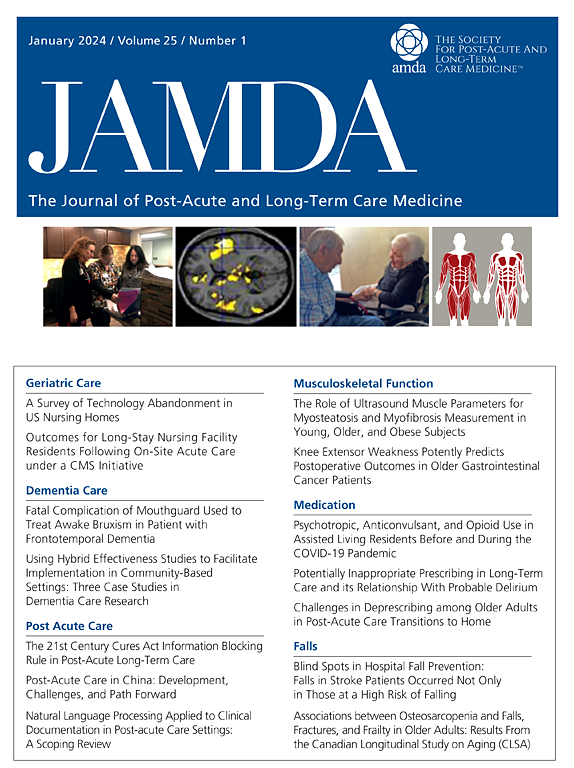辅助生活、寄宿护理和记忆性护理人员配备水平动态:俄勒冈州,2017-2023 年。
IF 3.8
2区 医学
Q2 GERIATRICS & GERONTOLOGY
Journal of the American Medical Directors Association
Pub Date : 2024-11-12
DOI:10.1016/j.jamda.2024.105352
引用次数: 0
摘要
目标研究俄勒冈州辅助生活和寄宿护理(AL/RC)社区在 2017 年至 2023 年期间人员配备水平的变化情况:设计:对获得许可的 AL/RC 社区进行纵向研究:2017年至2023年期间,俄勒冈州535个AL/RC社区共进行了1720次设置年观察:主要数据通过俄勒冈州社区护理(CBC)研究收集。人员配备水平按护理人员每天为每位居民服务的小时数估算,并按人员类型(包括注册护士、持证执业护士、注册护理助理、注册药物助理、无证护理人员、生活充实人员和社会工作者)进行整体报告。对固定效应线性回归模型进行了估计,以考虑面板数据中的时间不变特征:每位住院患者每天的平均护理人员工作时间为 3 小时 30 分钟(范围为 3 小时 11 分钟至 4 小时 1 分钟),具体取决于调查年份。平均入住率为 77.5%,在大流行期间从 80.3% 显著降至 72.2%(P < .001)。各 AL/RC 机构的人员配备水平(总体水平和人员类型)差异显著。大流行开始后,人员配备水平立即上升。大部分(64%)观察到的人员配置水平差异可归因于 AL/RC 之间的差异。与 2017 年相比,2021 年和 2023 年的护理人员总数分别平均增加了 19 分钟和 28 分钟:人员配备水平的巨大差异表明,不同社区的运营结构、资源分配和居民特征存在显著差异,这对为居民提供的护理质量产生了影响。了解 COVID-19 大流行后人员配置模式(水平和组合)的重大变化对于制定政策以提高 AL/RC 机构的适应性和复原力至关重要。本文章由计算机程序翻译,如有差异,请以英文原文为准。
Assisted Living, Residential Care, and Memory Care Staffing Level Dynamics: Oregon, 2017–2023
Objectives
To examine changes in staffing levels over time in Oregon assisted living and residential care (AL/RC) communities between 2017 and 2023.
Design
Longitudinal study of licensed AL/RC communities.
Setting and Participants
A total of 1720 setting-year observations from 535 individual AL/RC communities in Oregon between 2017 and 2023.
Methods
Primary data were collected through the Oregon Community-Based Care (CBC) study. Staffing levels were estimated as care staff hours per resident per day and reported overall and by staff type, including registered nurses, licensed practical nurses, certified nursing assistants, certified medication aides, unlicensed care staff, life enrichment staff, and social workers. Fixed-effects linear regression models were estimated to account for the time-invariant characteristics in the panel data.
Results
The mean care staff hours per resident per day was 3 hours and 30 minutes (range, 3 hours and 11 minutes to 4 hours and 1 minute), depending on the survey setting year. The mean occupancy rate was 77.5% and declined significantly from 80.3% to 72.2% during the pandemic (P < .001). Staffing levels (overall and by staff type) varied significantly across AL/RC settings. There was an increase in staffing levels immediately after the pandemic started. Most (64%) of the variation observed in staffing levels could be attributed to between-AL/RC differences. On average, total care staff levels were 19 minutes higher in 2021 and 28 minutes higher in 2023 compared with 2017.
Conclusions and Implications
The wide range of staffing levels points to significant differences in operational structures, resource allocations, and resident characteristics across different communities, with implications for the quality of care provided to residents. Understanding the significant changes to staffing patterns (levels and mix) after the COVID-19 pandemic is crucial for developing policies to improve adaptability and resilience of AL/RC settings.
求助全文
通过发布文献求助,成功后即可免费获取论文全文。
去求助
来源期刊
CiteScore
11.10
自引率
6.60%
发文量
472
审稿时长
44 days
期刊介绍:
JAMDA, the official journal of AMDA - The Society for Post-Acute and Long-Term Care Medicine, is a leading peer-reviewed publication that offers practical information and research geared towards healthcare professionals in the post-acute and long-term care fields. It is also a valuable resource for policy-makers, organizational leaders, educators, and advocates.
The journal provides essential information for various healthcare professionals such as medical directors, attending physicians, nurses, consultant pharmacists, geriatric psychiatrists, nurse practitioners, physician assistants, physical and occupational therapists, social workers, and others involved in providing, overseeing, and promoting quality

 求助内容:
求助内容: 应助结果提醒方式:
应助结果提醒方式:


